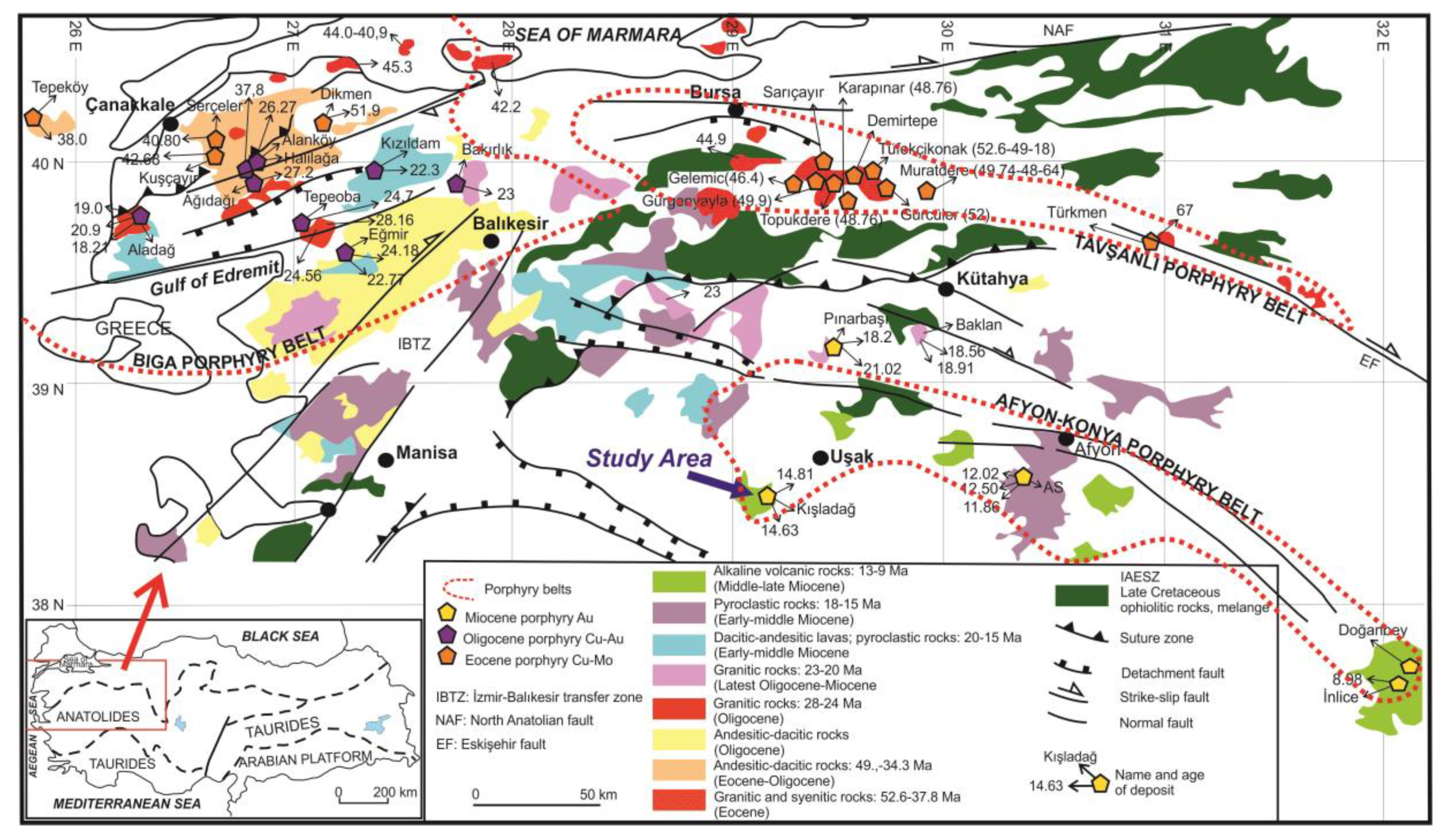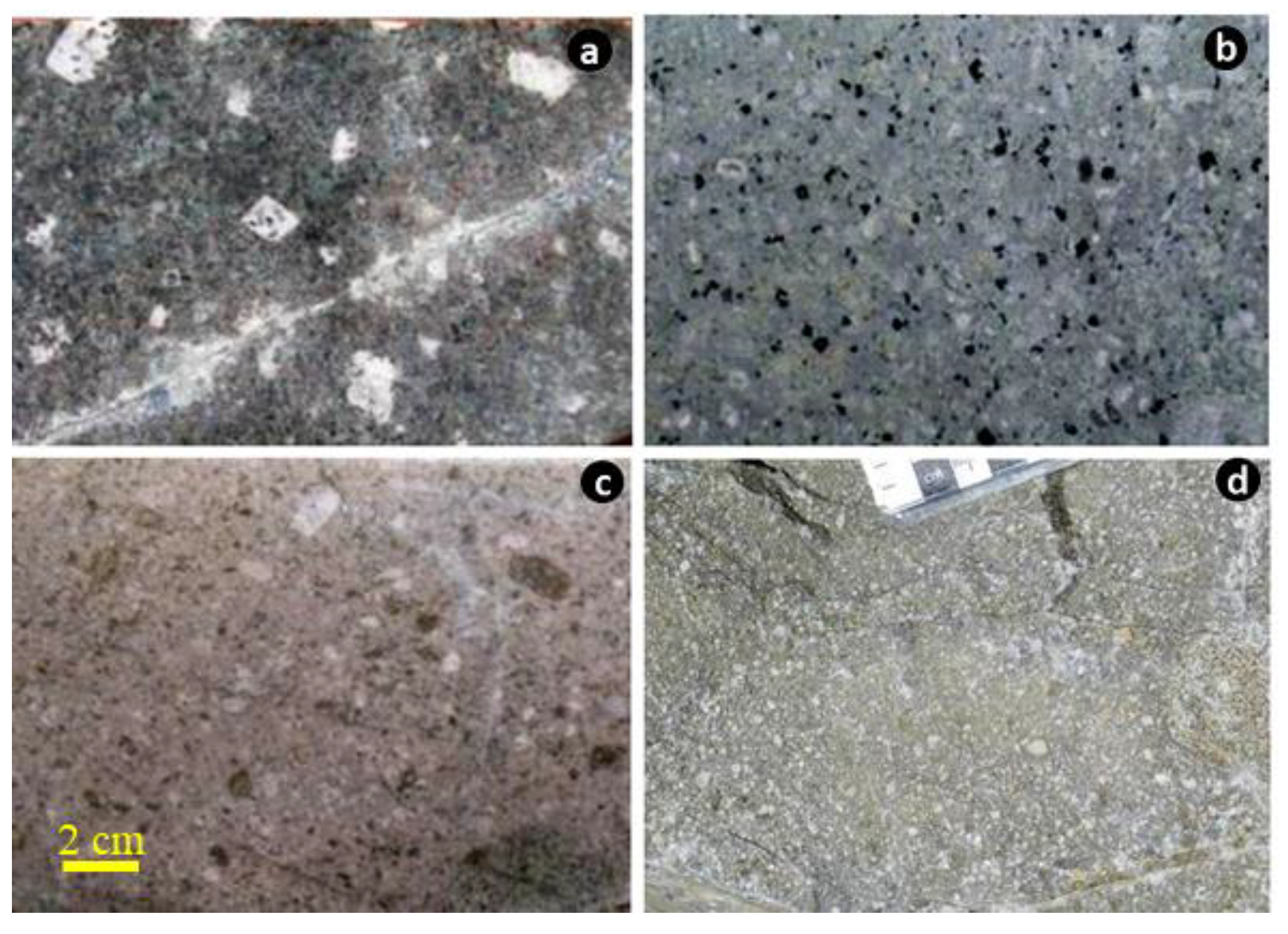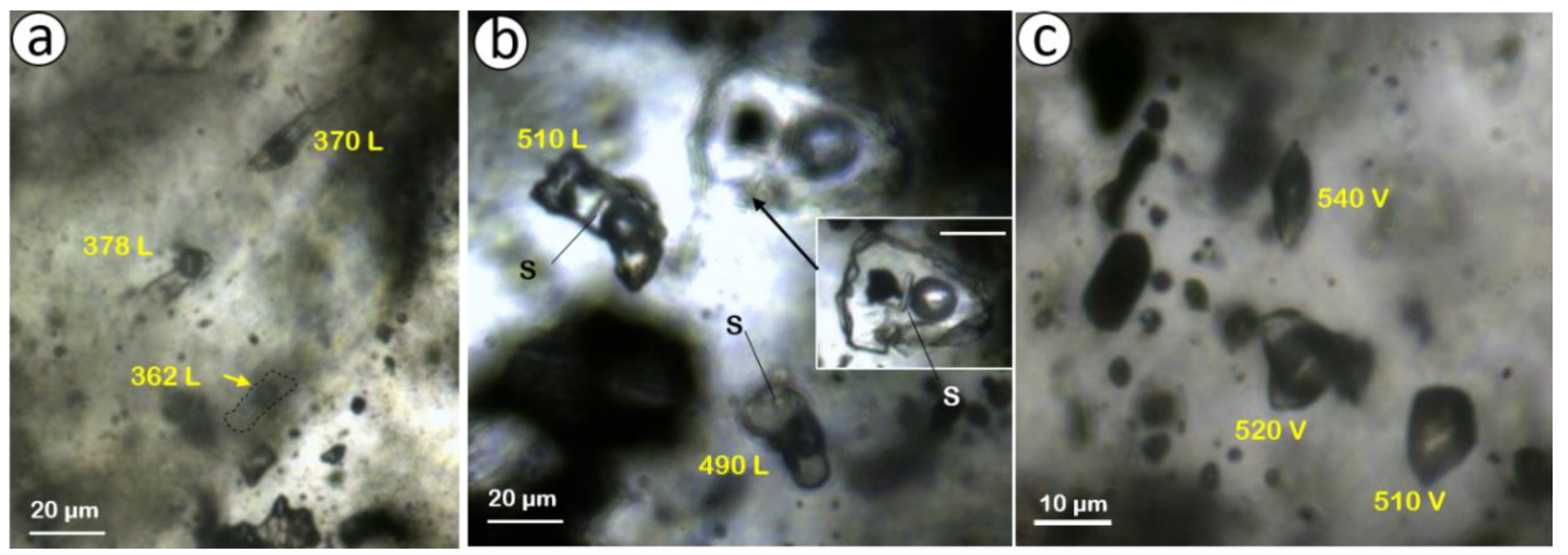Fluid Inclusion Characteristics of the Kışladağ Porphyry Au Deposit, Western Turkey
Abstract
:1. Introduction
2. Geological and Lithological Features
2.1. Metamorphic Basement
2.2. Intrusive Rocks
2.2.1. Intrusion 1 (INT#1)
2.2.2. Intrusion 2 and 2A (INT#2 and INT#2A)
2.2.3. Intrusion 3 (INT#3)
2.2.4. Latite Porphyry and Volcanoclastic Rocks
2.3. Mineralization and Alteration
3. Materials and Methods
4. Results
4.1. Scanning Electron Microscope-Catholuminescence (SEM-CL) Imaging
4.2. Fluid Inclusion Studies
4.2.1. Intrusion#1 (INT#1)
4.2.2. Intrusion#2 (INT#2)
4.2.3. Intrusion#3 (INT#3)
5. Discussion and Conclusions
Author Contributions
Funding
Acknowledgments
Conflicts of Interest
References
- Reynolds, N.; Large, D. Tethyan zinc–lead metallogeny in Europe, North Africa, and Asia. Soc. Econ. Geol. Spec. Pub. 2010, 15, 339–365. [Google Scholar]
- Richards, J.P. Tectonic, magmatic, and metallogenic evolution of the Tethyan orogeny: From subduction to collision. Ore Geol. Rev. 2015, 70, 323–345. [Google Scholar] [CrossRef]
- Şengör, A.M.C.; Yılmaz, Y. Tethyan evolution of Turkey: A plate tectonic approach. Tectonophysics 1981, 75, 181–241. [Google Scholar] [CrossRef]
- Elmas, A.; Yılmaz, Y. Development of an oblique subduction zone tectonic evolution of the Tethys Suture zone in Southeast Turkey. Int. Geol. Rev. 2003, 5, 827–840. [Google Scholar] [CrossRef]
- Seyitoğlu, G.; Scott, B.C. Late Cenozoic crustal extension and basin formation in west Turkey. Geol. Mag. 1991, 128, 155–166. [Google Scholar] [CrossRef]
- Bozkurt, E.; Mittwede, S.K. Introduction: Evolution of continental extensional tectonics of western Turkey. Geodin. Acta 2005, 18, 153–165. [Google Scholar] [CrossRef]
- Yılmaz, Y. The origin of young volcanic rocks of western Turkey. In Tectonic Evolution of the Tethyan Region; Sengor, A.M.C., Ed.; Springer: Dordrecht, The Netherlands, 1989; Volume 259, pp. 159–189. [Google Scholar]
- Savaşçın, M.Y. Magmatic activities of Cenozoic compressional and extensional tectonic regimes in western Anatolia. In Proceedings of the International Earth Sciences Congress on Aegean Regions (IESCA), Izmir, Turkey, 1–6 October 1990; pp. 420–434. [Google Scholar]
- Yılmaz, Y. Morphotectonic Development of Anatolia and the Surrounding Regions. In Active Global Seismology: Neotectonics and Earthquake Potential of the Eastern Mediterranean Region, 1st ed.; Geophysical Monograph 225; Çemen, İ., Yılmaz, Y., Eds.; John Wiley & Sons, Inc.: Hoboken, NJ, USA, 2012; pp. 11–91. [Google Scholar]
- Koçyiğit, A.; Yusufoğlu, H.; Bozkurt, E. Evidence from the Gediz graben for episodic two-stage extension in western Turkey. J. Geol. Soc. (Lond.) 1999, 156, 605–616. [Google Scholar] [CrossRef]
- Karaoğlu, Ö.; Helvacı, C. Growth, destruction and volcanic facies architecture of three volcanic centres in the Miocene Uşak–Güre basins: A contribution to the discussion on the development of east–west and north trending basins in western Turkey. Geol. Mag. 2012, 134, 163–175. [Google Scholar]
- Kuşcu, İ.; Tosdal, R.M.; Gençalioğlu-Kuşcu, G. Porphyry-Cu Deposits of Turkey. In Mineral Resources of Turkey Modern Approaches in Solid Earth Sciences; Pirajno, F., Ünlü, T., Dönmez, C., Şahin, M., Eds.; Springer: Cham, Switzerland, 2019; Volume 16, pp. 337–425. [Google Scholar]
- Available online: https://www.eldoradogold.com/news-and-media/news-releases/press-release-details/2018/Eldorado-Gold-Releases-Updated-Reserve-and-Resource-Statement/default.aspx (accessed on 1 November 2019).
- Baker, T.; Bickford, D.; Juras, S.; Lewis, P.; Oztas, Y.; Ross, K.; Tukac, A.; Rabayrol, F.; Miskovic, A.; Friedman, R.; et al. The Geology of the Kışladağ Porphyry Gold Deposit, Turkey. In Tectonics and Metallogeny of the Tethyan Orogenic Belt; Richards, J.P.R., Ed.; Special Publication Society of Economic Geologists, GeoScienceWorld: Virginia, VA, USA, 2016; Volume 19, pp. 57–83. [Google Scholar]
- Karaoğlu, Ö.; Helvacı, C.; Ersoy, Y. Petrogenesis and 40Ar/39Ar geochronology of the volcanic rocks of the Uşak-Güre basin, western Türkiye. Lithos 2010, 119, 193–210. [Google Scholar] [CrossRef]
- Seyitoğlu, G. Late Cenozoic tectono-sedimentary development of the Selendi and Uşak–Güre basins: A contribution to the discussion on the development of east–west and north trending basins in western Turkey. Geol. Mag. 1997, 134, 163–175. [Google Scholar] [CrossRef]
- Juras, S.; Miller, R.; Skayman, P. Technical Report for the Kışladağ Gold Mine. Prep. Eldorado Gold 2010, 43–101, 150. [Google Scholar]
- Lowell, J.D.; Guilbert, J.M. Lateral and vertical alteration-mineralization zoning in porphyry ore deposits. Econ. Geol. 1970, 65, 373–408. [Google Scholar] [CrossRef]
- Sillitoe, R.H. The tops and bottoms of porphyry copper deposits. Econ. Geol. 1973, 68, 799–815. [Google Scholar] [CrossRef]
- Bozkaya, Ö.; Bozkaya, G.; Hanilçi, N.; Laçin, D.; Banks, D.A.; Uysal, I.T. Mineralogical and geochemical evidence of late epithermal alteration in the Kisladag porphyry gold deposit, Usak, Western Turkey. In Life with Ore Deposits on Earth, Proceedings of the 15th Biennial SGA Conference, Glasgow, UK, 27–30 August 2019; Society for Geology Applied to Mineral Deposits, University of Glasgow: Scotland, UK, 2019; Volume 3, pp. 1031–1034. [Google Scholar]
- Roedder, E. Fluid inclusion evidence for immiscibility in magmatic differentiation. Geochim. Cosmochim. Acta 1992, 56, 5–20. [Google Scholar] [CrossRef]
- Shepherd, T.; Rankin, A.H.; Alderton, D.H.M. A Practical Guide to Fluid Inclusion Studies; Blackie: Glasgow, UK, 1985; p. 239. [Google Scholar]
- Lang, X.; Wang, X.; Deng, Y.; Tang, J.; Xie, F.; Yang, Z. Hydrothermal evolution and ore precipitation of the No. 2 porphyry Cu–Au deposit in the Xiongcun district, Tibet: Evidence from cathodoluminescence, fluid inclusions, and isotopes. Ore Geol. Rev. 2019, 114, 103141. [Google Scholar] [CrossRef]
- Rusk, B.G.; Reed, M.H. Scanning electron microscope-cathodoluminescence of quartz reveals complex growth histories in veins from the Butte porphyry copper deposit, Montana. Geology 2002, 30, 727–730. [Google Scholar] [CrossRef]
- Redmond, P.B.; Einaudi, M.T.; Inan, E.E.; Landtwing, M.R.; Heinrich, C.A. Copper deposition by fluid cooling in intrusion-centered systems: New insights from the Bingham porphyry ore deposit, Utah. Geology 2004, 32, 217–220. [Google Scholar] [CrossRef]
- Van den Kerkhof, A.M.; Hein, U.F. Fluid inclusion petrography. Lithos 2001, 55, 27–47. [Google Scholar] [CrossRef]
- Klemm, L.M.; Pettke, T.; Heinrich, C.A.; Campos, E. Hydrothermal evolution of the El Teniente deposit, Chile: Porphyry Cu-Mo ore deposition from low-salinity magmatic fluids. Econ. Geol. 2007, 102, 1021–1045. [Google Scholar] [CrossRef]
- Batkhishig, B.; Bignal, G.; Tsuchya, N. Hydrothermal quartz vein formation, revealed by coupled SEM-CL imaging and fluid inclusion microthermometry: Shuteen Complex, South Gobi, Mongolia. Resour. Geol. 2005, 55, 1–8. [Google Scholar] [CrossRef]
- Cooke, D.R.; Hollings, P.; Wilkinson, J.J.; Tosdal, R.M. Geochemistry of Porphyry Deposits. In Treatise on Geochemistry, 2nd ed.; Holland, H.D., Turekian, K.K., Eds.; Elsevier: Oxford, UK, 2014; Volume 13, pp. 357–381. [Google Scholar]
- Rusk, B.G.; Reed, M.H.; Dilles, J.H. Fluid inclusion evidence for magmatic-hydrothermal fluid evolution in the porphyry copper-molybdenium deposit at Butte, Montana. Econ. Geol. 2008, 103, 307–334. [Google Scholar] [CrossRef]
- Müller, A.; Herrington, R.; Armstrong, R.; Seltman, R.; Kirwin, D.J.; Stenina, N.G.; Kronz, A. Trace elements and cathodoluminesence of quartz in stockwork veins of Mongolian porpyhyry-style deposits. Miner. Depos. 2010, 45, 707–727. [Google Scholar] [CrossRef] [Green Version]
- Bodnar, J.R.; Vityk, M.O. Interpretation of microthermometric data for H2O-NaCl fluid inclusions. In Fluid Inclusions in Minerals: Methods and Applications; De Vivo, B., Frezzotti, M.L., Eds.; Virginia Technical Institute: Blacksburg, VA, USA, 1994; pp. 117–130. [Google Scholar]
- Bodnar, R.J.; Lecumberri-Sanchez, P.; Moncada, D.; Steele-MacInnis, M. Fluid Inclusions in Hydrothermal Ore Deposits. In Treatise on Geochemistry, 2nd ed.; Holland, H.D., Turekian, K.K., Eds.; Elsevier: Oxford, UK, 2014; Volume 13, pp. 119–142. [Google Scholar]
- Cooke, D.R.; Hollings, P.; Walsh, J.L. Giant porphyry deposits: Characteristics, distribution, and tectonic controls. Econ. Geol. 2005, 100, 801–818. [Google Scholar] [CrossRef]
- Sillitoe, R.H. Porphyry copper systems. Econ. Geol. 2010, 105, 3–41. [Google Scholar] [CrossRef] [Green Version]













| Intrusion | Vein Type | Quartz Generation | Fluid Inclusion Type, (n) | Te °C | Tm-CO2 °C | Tm-Ice °C | Tm-Clth °C | Th-CO2 °C | Tm-Halite °C | Salinity NaCl wt % equiv. | Th Values °C | Th Mode |
|---|---|---|---|---|---|---|---|---|---|---|---|---|
| INT#1 | V1 | Q1 | LVS, (5) | −70 to −17 | - | - | - | - | 250 to 412 | 34 to 49 | 435 to 510 | L |
| V1 | Q1 | LV (7) | −71 to −30 | - | −7 to −1 | - | - | - | 2 to 11 | 293 to 378 | L | |
| V1 | Q1 | VL (3) | n.d. | - | −5.3 to −1.8 | - | - | - | 1 to 7 | 424 to 520 | V | |
| V1 | Q2 | LV (3) | n.d. | - | −8 to −1 | - | - | - | 3 to 11 | 336 to 346 | L | |
| V1 | Q2 | LCV (4) | −70 to −67 | −58.5 to −54 | - | - | 21 | - | - | 350 | L | |
| V1 | Q2–Q4 | LVS | −26 | - | - | - | - | 112 to 261 | 28 to 35 | 250 to 351 | L | |
| V1 | Q2–Q4 | LV (14) | −45 to −26 | - | −8.5 to −2 | 2.6 | - | - | 3 to 12.5 | 257 to 333 | L | |
| INT#2 | V1 | Q1 | LV (4) | −68 to −43 | - | −11 to −14 | - | - | - | 15 to 18 | 371 to 443 | L |
| V1 | Q1 | VL (4) | −68 to −38 | - | - | - | - | - | - | 480 to 594 | V | |
| V1 | Q2 | LV (10) | −52 to −28 | - | −17 to −5 | - | - | - | 20 to 7.5 | 303 to 380 | L | |
| V1 | Q2 | VL (2) | −38 to −36 | - | −11 to −4 | - | - | - | 15 to 7 | 377 to 381 | V | |
| V2 | Q3 | LV (3) | −42 to −37 | - | −7 to −5 | - | - | - | 10 to 7 | 340 to 300 | L | |
| INT#3 | V1 | Q1 | LVS (2) | −93 to −40 | - | - | - | - | 228 to 219 | 33 | 412 to 469 | L |
| V1 | Q1 | LV (8) | −101 to −40 | - | −10.4 | 7.2 | - | 15 to 5 | 310 to 520 | L | ||
| V1 | Q1 | VL (2) | −90.3 | - | - | 7.8 | - | - | 4.3 | 600 | V | |
| V2 | Q3 | LV (5) | −26.4 | - | −4.8 to −3.3 | - | - | - | 7.6 to 5.4 | 373 to 310 | L |
© 2020 by the authors. Licensee MDPI, Basel, Switzerland. This article is an open access article distributed under the terms and conditions of the Creative Commons Attribution (CC BY) license (http://creativecommons.org/licenses/by/4.0/).
Share and Cite
Hanilçi, N.; Bozkaya, G.; Banks, D.A.; Bozkaya, Ö.; Prokofiev, V.; Öztaş, Y. Fluid Inclusion Characteristics of the Kışladağ Porphyry Au Deposit, Western Turkey. Minerals 2020, 10, 64. https://doi.org/10.3390/min10010064
Hanilçi N, Bozkaya G, Banks DA, Bozkaya Ö, Prokofiev V, Öztaş Y. Fluid Inclusion Characteristics of the Kışladağ Porphyry Au Deposit, Western Turkey. Minerals. 2020; 10(1):64. https://doi.org/10.3390/min10010064
Chicago/Turabian StyleHanilçi, Nurullah, Gülcan Bozkaya, David A. Banks, Ömer Bozkaya, Vsevolod Prokofiev, and Yücel Öztaş. 2020. "Fluid Inclusion Characteristics of the Kışladağ Porphyry Au Deposit, Western Turkey" Minerals 10, no. 1: 64. https://doi.org/10.3390/min10010064
APA StyleHanilçi, N., Bozkaya, G., Banks, D. A., Bozkaya, Ö., Prokofiev, V., & Öztaş, Y. (2020). Fluid Inclusion Characteristics of the Kışladağ Porphyry Au Deposit, Western Turkey. Minerals, 10(1), 64. https://doi.org/10.3390/min10010064








